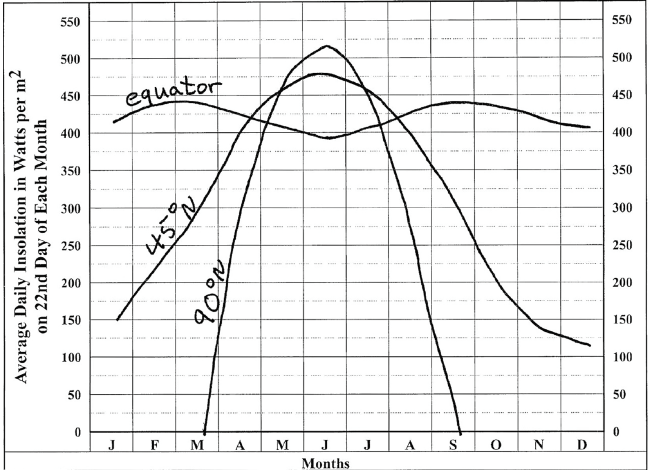The Kyoto Protocol calls for an overall reduction of greenhouse gases of 5.3% below the 1990 levels. What was the average level of CO2 in 1990? What would the level of CO2 be if the Kyoto goal was met? How many ppm below current levels would that be? The “Group of 77” countries favor a 15% reduction below 1990 levels. What would that level be, and how far below present levels is it?
What will be an ideal response?
The CO2 level in 1990 was 354.16 ppm. To meet the 5.3% reduction goals, the CO2 level would have to be lower than 335.38 ppm. A 15% reduction would result in CO2 level of 301.03 ppm, which is almost 100 ppm lower than present level.
You might also like to view...
On the chart, use the data to plot the average daily insolation at the top of the atmosphere (in W>m2) for the 22nd day of each month at the equator, 45° N, and 90° N. Connect the values for each latitude with a labeled line (you may also use a red line for the equator, a green line for 45° N, and a blue line for 90° N).

Answer the following questions. Keep in mind that these data show the insolation at the top of the atmosphere—they take into account the angle of incidence of incoming radiation and the length of day, but ignore the effects of the atmosphere.After completing the chart, answer the following questions. Keep in mind that these data show the insolation at the top of the atmosphere—they take into account the angle of incidence of incoming radiation and the length of day, but ignore the effects of the atmosphere.
(a) During a year, which of the three latitudes experiences the least variation in average daily insolation at the top of the atmosphere? Why?
(b) During a year, which of the three latitudes experiences the greatest variation in average daily insolation at the top of the atmosphere? Why?
(c) For how many months of the year does the North Pole receive no insolation? (Note: When answering this question you need to consider the actual period of time the North Pole goes without sunlight each year—interpret Figure 11-3 and your chart in problem 4 carefully; you should be able to answer this question without looking at Figure 11-3 or your chart.)
(d) Which dates mark the beginning and end of this period of zero insolation at the North Pole?
Why does a star's color corresponds to its temperature?
A. Because the ultraviolet output of a star directly modifies the visible light spectrum the star is emitting B. Because of the light shifts that take place when star light interacts with the Earth's atmosphere C. Higher temperature means more energetic light, which is seen as higher frequencies. D. Because the core temperature averages with the surface temperature to create an overall color
Small changes in Earth?Sun orbital geometry that resulted in Quaternary glacial and interglacial cycles are called
A) Milankovitch cycles. B) carbon cycles. C) Keeling curves. D) sunspot cycles.
If the magma cools and solidifies below the surface, it crystallizes as volcanic rocks.
Answer the following statement true (T) or false (F)